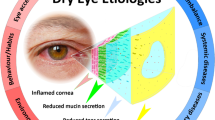Abstract
Purpose
Glaucoma is the leading cause for blindness after cataracts worldwide. The aim was to identify anticholinergic drugs prescribed to patients diagnosed with closed-angle glaucoma in Colombia.
Methods
This cross-sectional study identified the prescribing patterns of cholinergic antagonists related to the increased intraocular pressure in patients diagnosed with closed-angle glaucoma from a Colombian database. The Anticholinergic Drug Scale was used to quantify the anticholinergic burden.
Results
We identified 1958 patients with closed-angle glaucoma, with a mean age of 70.5 ± 10.3 years, 72.9% of whom were women. Cholinergic antagonists were prescribed in at least 32.4% of cases. An age range between 75 and 84 years (odds ratio (OR) 2.35, 95% confidence interval (CI) 1.366–4.059) and being aged 85 years or older (OR 3.40, 95% CI 1.809–6.425) were associated with a greater probability of receiving an anticholinergic burden between 1 and 2 points. Females (OR 1.54, 95% CI 1.096–2.181) had a higher probability of receiving an anticholinergic burden ≥ 3 points. Interactions between antiglaucoma medications and anticholinergic treatments were identified in 32.1% of the patients.
Conclusions
Most patients were prescribed multiple antiglaucoma medications, reflecting a large number of potentially inappropriate prescriptions, with anticholinergic drugs, related to the increased intraocular pressure.
Similar content being viewed by others
References
Jonas JB, Aung T, Bourne RR et al (2017) Glaucoma. Lancet 390(10108):2183–2193
Mantravadi AV, Vadhar N (2015) Glaucoma. Prim Care 42(3):437–449
Zhao Y, Fu JL, Li YL et al (2015) Epidemiology and clinical characteristics of patients with glaucoma: an analysis of hospital data between 2003 and 2012. Indian J Ophthalmol 63(11):825–831
Sawaguchi S, Sakai H, Iwase A et al (2012) Prevalence of primary angle closure and primary angle-closure glaucoma in a southwestern rural population of Japan: the Kumejima study. Ophthalmology 119(6):1134–1142
Hohn R, Nickels S, Schuster AK et al (2018) Prevalence of glaucoma in Germany: results from the Gutenberg Health Study. Graefes Arch Clin Exp Ophthalmol 256(9):1695–1702
Kolko M, Horwitz A, Thygesen J et al (2015) The prevalence and incidence of glaucoma in Denmark in a fifteen year period: a nationwide study. PLoS ONE 10(7):e0132048
Tham YC, Li X, Wong TY et al (2014) Global prevalence of glaucoma and projections of glaucoma burden through 2040: a systematic review and meta-analysis. Ophthalmology 121(11):2081–2090
Ko YC, Liu CJ, Hsu WM et al (2015) Determinants and characteristics of angle-closure disease in an elderly Chinese population. Ophthalmic Epidemiol 22(2):109–115
Sun X, Dai Y, Chen Y et al (2017) Primary angle closure glaucoma: what we know and what we don’t know. Prog Retin Eye Res 57:26–45
Razeghinejad MR, Myers JS, Katz LJ (2011) Iatrogenic glaucoma secondary to medications. Am J Med 124(1):20–25
Patel K, Patel S (2014) Angle-closure glaucoma. Dis Mon 60(6):254–262
Ah-Kee EY, Egong E, Shafi A et al (2015) A review of drug-induced acute angle closure glaucoma for non-ophthalmologists. Qatar Med J 1:6
Vélez-Gómez MC, Vásquez-Trespalacios EM (2018) Adherence to topical treatment of glaucoma, risk and protective factors: a review. Arch Soc Esp Oftalmol 93(2):87–92
Nishtala PS, Salahudeen MS, Hilmer SN (2016) Anticholinergics: theoretical and clinical overview. Expert Opin Drug Saf 15(6):753–768
Collamati A, Martone AM, Poscia A et al (2016) Anticholinergic drugs and negative outcomes in the older population: from biological plausibility to clinical evidence. Aging Clin Exp Res 28(1):25–35
Carnahan RM, Lund BC, Perry PJ et al (2006) The Anticholinergic Drug Scale as a measure of drug-related anticholinergic burden: associations with serum anticholinergic activity. J Clin Pharmacol 46(12):1481–1486
Fea AM, Dallorto L, Lavia C et al (2018) Long-term outcomes after acute primary angle closure of Caucasian chronic angle closure glaucoma patients. Clin Exp Ophthalmol 46(3):232–239
Lai JS, Liu DT, Tham CC et al (2001) Epidemiology of acute primary angle-closure glaucoma in the Hong Kong Chinese population: prospective study. Hong Kong Med J 7(2):118–123
Chua PY, Day AC, Lai KL, et al. (2017) The incidence of acute angle closure in Scotland: a prospective surveillance study. Br J Ophthalmol. https://doi.org/10.1136/bjophthalmol-2017-310725. Epub ahead of print
Rieger-Reyes C, Rubio-Galán FJ (2013) Glaucoma: pharmacological implications. Semergen 39(1):26–33
Conlon R, Saheb H, Ahmed II (2017) Glaucoma treatment trends: a review. Can J Ophthalmol 52(1):114–124
Kim CY, Park KH, Ahn J et al (2017) Treatment patterns and medication adherence of patients with glaucoma in South Korea. Br J Ophthalmol 101(6):801–807
Chassid O, Epstein I, Sharabi-Nov A et al (2018) Prevalence of glaucoma in the Israeli Arab population. Int J Ophthalmol 11(1):163–165
Machado-Alba J, Hoyos-Soto V (2014) Frequency of coprescription and potential risk of bronchospasm in colombian patients users of topical antiglaucomatous betablockers and bronchodilators. Vitae 21:107–113
Kalouda P, Keskini C, Anastasopoulos E et al (2017) Achievements and limits of current medical therapy of glaucoma. Dev Ophthalmol 59:1–14
Bower T, Samek DA, Mohammed A et al (2018) Systemic medication usage in glaucoma patients. Can J Ophthalmol 53(3):242–245
Gerretsen P, Pollock BG (2011) Drugs with anticholinergic properties: a current perspective on use and safety. Expert Opin Drug Saf 10(5):751–765
O’Mahony D, O’Sullivan D, Byrne S et al (2015) STOPP/START criteria for potentially inappropriate prescribing in older people: version 2. Age Ageing 44(2):213–218
Badhu BP, Bhattarai B, Sangraula HP (2013) Drug-induced ocular hypertension and angle-closure glaucoma. Asia Pac J Ophthalmol (Phila) 2(3):173–176
Khurana AK, Khurana B, Khurana AK (2012) Drug-induced angle-closure glaucoma. J Curr Glaucoma Pract 6(1):6–8
Acknowledgements
We thank Soffy Claritza López for her work in obtaining the database.
Funding
This work did not receive funding.
Author information
Authors and Affiliations
Corresponding author
Ethics declarations
Conflict of interests
The authors declare that they have no conflict of interest.
Additional information
Publisher's Note
Springer Nature remains neutral with regard to jurisdictional claims in published maps and institutional affiliations.
Rights and permissions
About this article
Cite this article
Valladales-Restrepo, L.F., Machado-Alba, J.E. Potentially inappropriate prescriptions of anticholinergic medications in patients with closed-angle glaucoma. Int Ophthalmol 40, 803–809 (2020). https://doi.org/10.1007/s10792-019-01241-2
Received:
Accepted:
Published:
Issue Date:
DOI: https://doi.org/10.1007/s10792-019-01241-2




